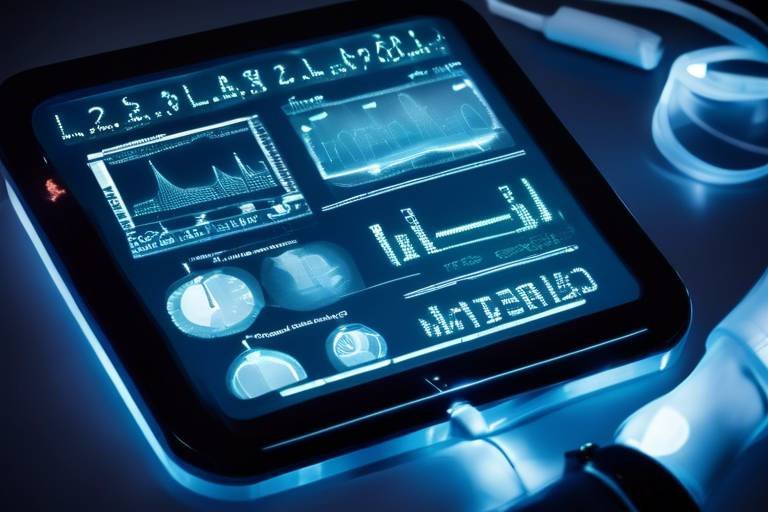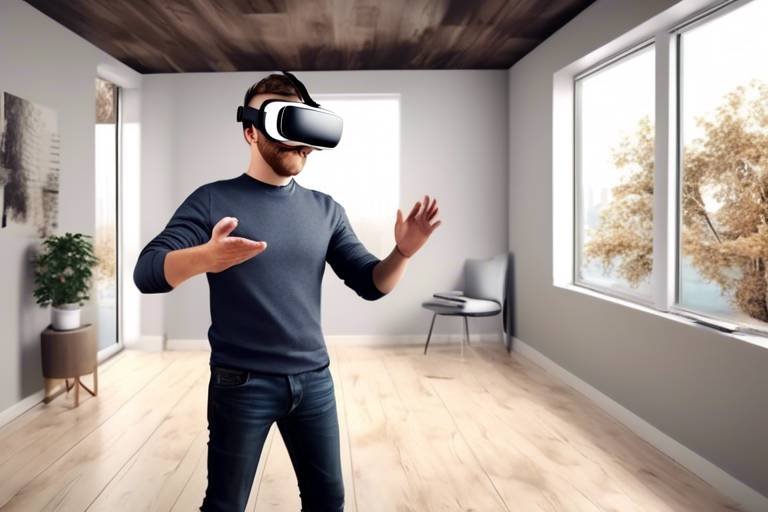The Role of Technology in Enhancing Global Health
In today's fast-paced world, the intersection of technology and healthcare is not just a trend; it's a revolution. As we navigate through challenges like pandemics, aging populations, and the rising burden of chronic diseases, technology emerges as a beacon of hope, offering innovative solutions that can enhance global health initiatives. From telemedicine to wearable devices, the advancements in technology are not merely improving access to care; they are fundamentally reshaping the way health systems operate worldwide.
Imagine a world where a patient in a remote village can consult a specialist thousands of miles away with just a click. This is the promise of telemedicine, which has effectively bridged the gaps in healthcare access, especially in underserved regions. It allows for timely consultations, reducing the need for long journeys to healthcare facilities and ensuring that patients receive the care they need when they need it. But it's not just about convenience; it's about improving patient outcomes, fostering a more inclusive healthcare environment, and ultimately saving lives.
Moreover, the rise of wearable health technology is empowering individuals like never before. With devices that track everything from heart rate to sleep patterns, people are becoming active participants in their own health management. This shift towards preventive care means that individuals can monitor their health in real-time, leading to early detection of potential issues. The data collected from these devices is not just numbers; it's a treasure trove of information that can guide lifestyle choices, making health management a personal and proactive journey.
However, with great power comes great responsibility. The integration of technology in healthcare is not without its challenges. Issues such as data privacy and user compliance are critical concerns that need to be addressed. As we embrace these innovative solutions, it’s essential to ensure that patient information remains secure and that users are motivated to engage with these technologies consistently.
As we delve deeper into the realm of healthcare technology, it becomes evident that the role of artificial intelligence (AI) is transformative. AI is enhancing diagnostics, making them more accurate and efficient. Machine learning algorithms are being utilized to detect diseases earlier, which can significantly improve treatment plans and patient outcomes. For instance, in radiology, AI applications are streamlining image analysis, allowing for faster and more precise diagnoses. This not only saves time but also enhances patient care by ensuring that critical conditions are identified promptly.
Furthermore, the use of Natural Language Processing (NLP) in health records is revolutionizing how we analyze and utilize patient data. By improving the way clinical information is processed, NLP enhances clinical decision-making, ultimately leading to better patient outcomes. The ability to extract meaningful insights from unstructured data means that healthcare providers can make informed decisions that are backed by comprehensive data analysis.
In conclusion, the role of technology in enhancing global health is multifaceted and profound. It’s not just about the tools we use; it’s about the lives we touch and the health outcomes we improve. As we continue to innovate and integrate these technologies into our healthcare systems, we must remain vigilant about the challenges that accompany them, ensuring that we create a future where technology serves as a powerful ally in the quest for better health for all.
- How does telemedicine improve healthcare access? Telemedicine allows patients to consult with healthcare providers remotely, reducing travel time and increasing access to specialists, especially in rural or underserved areas.
- What are the benefits of wearable health technology? Wearable devices empower individuals to monitor their health in real-time, promote preventive care, and enhance patient engagement in managing their own health.
- How does AI contribute to better diagnostics? AI enhances the accuracy and efficiency of diagnostics through machine learning algorithms that can detect diseases earlier and improve treatment plans.
- What challenges do wearable technologies face? Key challenges include data privacy concerns and ensuring user compliance in utilizing these technologies effectively.

Telemedicine: Bridging Gaps in Healthcare
Telemedicine has emerged as a game-changer in the healthcare landscape, especially in recent years. Imagine being able to consult with a specialist from the comfort of your home, without the hassle of long waiting times or travel expenses. This is not just a dream—it's the reality that telemedicine has brought to life. By leveraging technology, telemedicine is revolutionizing healthcare delivery, making it more accessible, efficient, and patient-centered.
One of the most significant benefits of telemedicine is its ability to increase access to healthcare services, particularly for individuals living in remote or underserved areas. In many cases, these individuals face barriers such as distance, lack of transportation, or limited availability of healthcare professionals. Telemedicine breaks down these barriers by providing a platform for remote consultations. Patients can connect with healthcare providers through video calls, phone consultations, or messaging, ensuring they receive the care they need without geographical limitations.
However, while the advantages of telemedicine are compelling, it is essential to acknowledge the challenges it faces. Issues such as technological barriers, including internet access and digital literacy, can hinder its effectiveness. Additionally, some patients may feel uncomfortable with virtual consultations, preferring the traditional face-to-face interaction. To address these challenges, healthcare systems must invest in training programs that educate both patients and providers on how to effectively use telemedicine technologies.
Another crucial aspect of telemedicine is its ability to improve patient outcomes. Studies have shown that patients who engage in telehealth services often report higher satisfaction levels and better management of chronic conditions. For example, a patient with diabetes can regularly monitor their blood sugar levels and share this data with their healthcare provider in real-time, allowing for timely interventions and adjustments to their treatment plan. This proactive approach not only enhances health outcomes but also fosters a sense of empowerment among patients, enabling them to take charge of their health.
To illustrate the impact of telemedicine, consider the following table that summarizes key benefits and challenges:
| Benefits | Challenges |
|---|---|
| Increased access to healthcare services | Technological barriers (internet access, digital literacy) |
| Improved patient outcomes and satisfaction | Patient comfort with virtual consultations |
| Cost-effective solutions for healthcare delivery | Regulatory and reimbursement issues |
In conclusion, telemedicine is undoubtedly bridging gaps in healthcare by enhancing access, improving outcomes, and empowering patients. As technology continues to evolve, it is essential for healthcare systems to adapt and embrace these innovative solutions. By addressing the challenges head-on and maximizing the benefits, we can create a future where healthcare is accessible to everyone, regardless of their location.
Frequently Asked Questions
- What is telemedicine? Telemedicine refers to the use of technology to provide healthcare services remotely, allowing patients to consult with healthcare providers without needing to visit a clinic or hospital.
- How does telemedicine improve access to healthcare? By enabling remote consultations, telemedicine eliminates geographical barriers, making it easier for individuals in rural or underserved areas to access healthcare services.
- What are the challenges of telemedicine? Challenges include technological barriers, patient comfort levels, and regulatory issues that may affect reimbursement for telehealth services.

Wearable Health Technology
In recent years, has emerged as a game-changer in the healthcare landscape. These innovative devices, which include smartwatches, fitness trackers, and even advanced health monitors, empower individuals to take charge of their health like never before. Imagine having the ability to track your heart rate, monitor your sleep patterns, and even measure your stress levels—all from a device that fits comfortably on your wrist. This newfound accessibility to health data not only promotes a sense of personal responsibility but also encourages preventive care, which can significantly alter health outcomes.
One of the most exciting aspects of wearable technology is its potential to enhance patient engagement. When individuals have real-time access to their health metrics, they are more likely to make informed decisions about their lifestyle choices. For instance, a person who sees their daily step count may feel motivated to increase their physical activity or adjust their diet based on their caloric burn. This shift from reactive to proactive health management is crucial in combating chronic diseases, which are often exacerbated by lifestyle factors.
However, the benefits of wearable health technology are not limited to individual users. Healthcare providers can also harness the power of these devices to improve patient care. By collecting and analyzing data from wearables, providers can gain valuable insights into patient health trends, allowing for more personalized treatment plans. For example, a doctor could receive alerts about a patient’s abnormal heart rate, prompting timely intervention before a more serious issue arises. This integration of technology into healthcare not only enhances the quality of care but also fosters a collaborative relationship between patients and providers.
Despite the clear advantages, there are challenges that come with the adoption of wearable health technology. Issues such as data privacy and security are at the forefront of concerns for both users and healthcare professionals. The sensitive nature of health data necessitates robust security measures to protect against breaches. Additionally, user compliance can be a hurdle; not everyone is motivated to wear these devices consistently. Manufacturers and healthcare providers must work together to create strategies that encourage regular use, such as gamifying the experience or providing incentives for meeting health goals.
| Benefits of Wearable Health Technology | Challenges |
|---|---|
| Promotes preventive care | Data privacy concerns |
| Enhances patient engagement | User compliance issues |
| Improves health monitoring | Integration with existing healthcare systems |
As we look to the future, the potential of wearable health technology is enormous. With ongoing advancements in technology, we can expect even more sophisticated devices that offer deeper insights into our health. From continuous glucose monitors for diabetics to advanced ECG monitors for heart health, the possibilities are endless. The key to unlocking this potential lies in collaboration among technology developers, healthcare providers, and patients. By working together, we can ensure that wearable technology not only enhances individual health management but also transforms the healthcare system as a whole.
- What is wearable health technology? Wearable health technology refers to devices that individuals can wear to monitor various health metrics, such as heart rate, activity levels, and sleep quality.
- How does wearable technology promote preventive care? By providing real-time health data, wearables empower users to make informed lifestyle choices that can prevent chronic diseases.
- What are the main challenges of using wearable health technology? Key challenges include data privacy concerns and ensuring user compliance with wearing the devices consistently.

Data Analytics in Health Monitoring
In today's fast-paced world, data analytics has emerged as a game-changer in health monitoring. Imagine having the power to understand your health in real-time, as if you had a personal health coach right on your wrist! Wearable devices collect an immense amount of data, from heart rate and sleep patterns to activity levels and even stress indicators. But what happens to all that data? This is where data analytics steps in, transforming raw numbers into actionable insights that can significantly enhance individual and public health outcomes.
By analyzing the data collected from wearables, healthcare professionals can identify trends and patterns that may indicate potential health issues. For instance, if a patient's heart rate consistently spikes during certain activities, it could signal an underlying condition that requires attention. This proactive approach not only helps in early detection but also empowers individuals to take charge of their health. It’s like having a crystal ball that reveals potential health risks before they become serious problems!
Moreover, data analytics enables healthcare providers to tailor interventions based on individual needs. Through sophisticated algorithms, healthcare professionals can segment populations and target specific groups with personalized health recommendations. This means that instead of a one-size-fits-all approach, patients receive advice that is relevant to their unique health profiles. For example, a person with a sedentary lifestyle might receive encouragement to engage in more physical activity, while someone with a history of hypertension may be advised on dietary changes to lower blood pressure.
To illustrate the impact of data analytics in health monitoring, consider the following table that summarizes key benefits:
| Benefit | Description |
|---|---|
| Early Detection | Identifies potential health issues before they escalate, allowing for timely intervention. |
| Personalized Care | Delivers tailored health recommendations based on individual data, enhancing engagement and compliance. |
| Population Health Insights | Analyzes trends across groups to inform public health strategies and resource allocation. |
| Improved Outcomes | Facilitates better healthcare decisions, leading to enhanced patient outcomes and satisfaction. |
However, it’s essential to recognize that with great power comes great responsibility. The use of data analytics in health monitoring raises important questions about data privacy and security. As individuals share their health information, ensuring that this data is protected from breaches is crucial. Healthcare providers must implement robust security measures and adhere to regulations to maintain patient trust.
In conclusion, data analytics in health monitoring is not just a trend; it’s a revolution. It empowers individuals to understand their health better, enables healthcare providers to deliver personalized care, and ultimately leads to improved health outcomes for communities worldwide. As technology continues to evolve, the synergy between data analytics and health monitoring will only deepen, paving the way for a healthier future.
- What is data analytics in health monitoring?
Data analytics in health monitoring involves analyzing health data collected from wearables to derive insights that can lead to better health decisions and outcomes. - How does data analytics benefit individual health?
It helps in early detection of potential health issues, provides personalized care recommendations, and enhances patient engagement in their health management. - Are there privacy concerns with health data analytics?
Yes, data privacy is a significant concern, and it is crucial for healthcare providers to implement strong security measures to protect patient information.

Predictive Analytics for Disease Prevention
In an era where technology is reshaping our approach to health, predictive analytics stands out as a game-changer in disease prevention. Imagine having the ability to foresee potential health risks before they manifest, much like a weather forecast predicting a storm. This proactive approach allows healthcare providers to implement strategies that can significantly reduce the incidence of diseases, ultimately saving lives and resources.
Predictive analytics employs advanced algorithms and data mining techniques to analyze vast amounts of health data. By examining patterns and trends, these tools can identify individuals at high risk for conditions such as diabetes, heart disease, or even certain cancers. For instance, a study by the American Journal of Preventive Medicine found that using predictive models could reduce hospital admissions for chronic illnesses by up to 30%. This statistic alone highlights the potential impact of predictive analytics in healthcare.
One of the most exciting aspects of predictive analytics is its ability to integrate data from various sources. This includes electronic health records (EHRs), genetic information, and even lifestyle factors gathered from wearable devices. By consolidating this information, healthcare providers can create a comprehensive view of a patient's health status. For example, a patient with a family history of heart disease who also exhibits high cholesterol levels can be flagged for early intervention strategies, such as dietary changes or medication.
Moreover, predictive analytics can enhance public health initiatives by identifying at-risk populations within communities. By analyzing demographic data alongside health outcomes, health authorities can target interventions more effectively. This means that resources can be allocated where they are needed most, whether through vaccination campaigns, health education programs, or screening initiatives.
However, while the benefits of predictive analytics are clear, there are challenges to consider. Data privacy is a significant concern, as individuals may be hesitant to share their personal health information. Additionally, the accuracy of predictive models is heavily reliant on the quality of the data collected. If the data is flawed or incomplete, it can lead to incorrect predictions, potentially causing harm rather than good.
In conclusion, predictive analytics is paving the way for a more proactive approach to health. By identifying risks before they escalate, healthcare providers can implement timely interventions that not only improve individual health outcomes but also enhance the efficiency of health systems as a whole. As technology continues to evolve, the integration of predictive analytics into everyday healthcare practices will undoubtedly revolutionize the way we approach disease prevention.
- What is predictive analytics in healthcare?
Predictive analytics in healthcare refers to the use of statistical techniques and algorithms to analyze current and historical data to predict future health outcomes.
- How can predictive analytics help prevent diseases?
By identifying at-risk individuals based on their health data, predictive analytics allows for early intervention strategies, reducing the likelihood of disease onset.
- What types of data are used in predictive analytics?
Data used can include electronic health records, genetic information, lifestyle factors, and data from wearable health technology.
- Are there any challenges associated with predictive analytics?
Yes, challenges include data privacy concerns, the quality of data, and the need for healthcare professionals to interpret and act on predictive insights accurately.

Personalized Health Recommendations
In today's fast-paced world, are becoming a game-changer in how individuals manage their health. Imagine having a health coach that fits right on your wrist, offering tailored advice based on your unique body metrics. This is precisely what wearable technology brings to the table. By collecting data like heart rate, activity levels, and even sleep patterns, these devices can analyze your health in real-time and provide insights that are specifically designed for you.
But how does this work? Well, let's break it down. Wearable devices gather a plethora of data throughout the day, which is then processed using sophisticated algorithms. For instance, if your wearable detects that your heart rate spikes during a workout, it can recommend a recovery period or suggest hydration tips. This kind of immediate feedback empowers users to make informed decisions about their health on the spot.
Moreover, the impact of personalized recommendations extends beyond just immediate advice. Over time, as these devices learn more about your habits and health patterns, they can offer long-term strategies that align with your lifestyle. For example, if you consistently struggle with sleep, your device might suggest a bedtime routine or relaxation techniques tailored to your preferences. This proactive approach not only enhances your health management but also fosters a deeper connection between you and your wellness journey.
However, the effectiveness of these personalized recommendations hinges on user engagement. The more you interact with your device, the better the insights it can provide. This creates a feedback loop where your health improves, leading to more data, which in turn leads to even better recommendations. It’s like having a personal trainer who gets to know you better with each session, allowing for increasingly effective strategies.
Of course, it’s essential to acknowledge that while personalized health recommendations are incredibly beneficial, they are not a one-size-fits-all solution. Factors like age, existing health conditions, and lifestyle choices all play a significant role in how effective these recommendations can be. Therefore, it's crucial to view these suggestions as a part of a broader health strategy that includes regular check-ups and consultations with healthcare professionals.
In conclusion, personalized health recommendations powered by wearable technology represent a significant leap forward in health management. By leveraging real-time data and analytics, individuals can take charge of their health in ways that were previously unimaginable. As we continue to embrace these innovations, the potential for improved health outcomes is not just a possibility—it's becoming a reality.
- What are personalized health recommendations?
They are tailored health suggestions based on individual data collected from wearable devices, helping users manage their health more effectively. - How do wearable devices provide personalized recommendations?
Wearables collect data such as activity levels, heart rate, and sleep patterns, which are analyzed to deliver customized insights. - Can personalized recommendations replace medical advice?
No, while they are helpful, they should complement professional medical advice rather than replace it. - What factors influence the effectiveness of these recommendations?
Age, existing health conditions, and lifestyle choices can all affect how well personalized recommendations work for an individual.

Challenges of Wearable Technology
While wearable technology has brought a wave of innovation to health monitoring and management, it is not without its challenges. One of the most pressing concerns is data privacy. With the vast amounts of personal health data being collected, users often worry about who has access to this information and how it is being used. For instance, imagine wearing a device that tracks your heart rate, sleep patterns, and even your stress levels. Now, picture that data being sold to third-party companies without your consent. This scenario raises significant ethical questions about privacy and security.
Another challenge is user compliance. While many individuals are excited about the prospect of monitoring their health in real-time, maintaining consistent use of these devices can be a hurdle. Studies suggest that a significant percentage of users abandon their wearables shortly after purchase. This drop-off can be attributed to several factors, including discomfort, lack of perceived benefit, or simply forgetting to wear the device. To illustrate this point, a recent survey found that:
| Reason for Discontinuation | Percentage of Users |
|---|---|
| Discomfort | 35% |
| Lack of perceived benefit | 30% |
| Forgetfulness | 25% |
| Technical issues | 10% |
Additionally, the accuracy of data collected by wearables can sometimes be questionable. Many devices rely on algorithms that may not always provide precise readings, leading users to make health decisions based on inaccurate information. For example, if a wearable device misreads a user's heart rate, it could potentially lead to unnecessary panic or, conversely, a false sense of security.
Lastly, there is the issue of integration with existing healthcare systems. Many healthcare providers are still adapting to the influx of data generated by wearables, and not all are equipped to interpret or utilize this information effectively. This disconnect can create a gap between the data collected and actionable healthcare interventions, ultimately hindering the potential benefits of wearable technology.
In summary, while wearable technology holds immense promise for enhancing personal health management, it is essential to address these challenges. By improving data privacy measures, encouraging user compliance, ensuring accuracy, and enhancing integration with healthcare systems, we can unlock the full potential of these innovative devices.
- What is wearable technology? Wearable technology refers to electronic devices that can be worn on the body, such as fitness trackers or smartwatches, which monitor various health metrics.
- How does wearable technology improve health? These devices provide real-time data on health metrics, encouraging proactive health management and preventive care.
- Are there privacy concerns with wearable technology? Yes, data privacy is a significant concern, as personal health information can be vulnerable to unauthorized access and misuse.
- What can be done to improve user compliance with wearables? Manufacturers can focus on enhancing comfort, providing clear benefits, and improving user engagement to encourage consistent use.

Artificial Intelligence in Diagnostics
Artificial Intelligence (AI) is not just a buzzword; it’s a game changer in the field of diagnostics. Imagine a world where diseases are detected not just early, but with pinpoint accuracy, allowing for timely interventions that can save lives. AI technologies are being integrated into various diagnostic processes, making them faster and more efficient. From analyzing medical images to interpreting lab results, AI is at the forefront of revolutionizing how we approach health assessments.
One of the most exciting applications of AI is in the realm of machine learning algorithms. These algorithms can sift through vast amounts of data and identify patterns that might escape even the most experienced healthcare professionals. For instance, in the case of radiology, AI can analyze thousands of X-rays or MRIs in a fraction of the time it would take a human, providing doctors with valuable insights that enhance their decision-making capabilities.
Moreover, AI is helping to reduce the rate of misdiagnosis, which can lead to inappropriate treatments and poor patient outcomes. By leveraging data from previous cases, AI systems can suggest potential diagnoses based on symptoms and imaging results. This not only improves the accuracy of diagnoses but also allows healthcare providers to explore a wider range of possibilities, ensuring that no stone is left unturned in the quest for the right treatment.
Let's take a closer look at how AI is reshaping diagnostics through some key areas:
- Enhanced Imaging Analysis: AI algorithms can analyze medical images with incredible precision, identifying anomalies that may not be visible to the naked eye.
- Speed and Efficiency: AI can process data much faster than humans, significantly reducing the time it takes to arrive at a diagnosis.
- Data-Driven Insights: The ability to analyze large datasets allows AI to provide insights that inform better clinical decisions.
However, the integration of AI in diagnostics is not without its challenges. Issues such as data privacy, the need for high-quality training data, and the potential for algorithmic bias must be addressed to ensure that AI technologies are both effective and equitable. As we move forward, it is crucial for stakeholders in the healthcare industry to work together to establish guidelines and frameworks that promote the responsible use of AI in diagnostics.
In conclusion, AI is paving the way for a new era in diagnostics, where accuracy and efficiency go hand in hand. As we continue to harness the power of technology, the future of healthcare looks promising, with the potential for better patient outcomes and a more responsive healthcare system.
- What is AI in diagnostics? AI in diagnostics refers to the use of artificial intelligence technologies to analyze medical data, improve diagnostic accuracy, and enhance patient care.
- How does AI improve diagnostic accuracy? AI algorithms can analyze vast datasets, identify patterns, and suggest potential diagnoses, which helps healthcare providers make more informed decisions.
- Are there any challenges associated with AI in diagnostics? Yes, challenges include data privacy concerns, the need for high-quality data, and the risk of algorithmic bias, which must be addressed to ensure equitable healthcare.

AI in Radiology
Artificial Intelligence (AI) is making waves in the field of radiology, fundamentally changing how we approach medical imaging. Imagine a world where radiologists can focus on the bigger picture, while AI handles the nitty-gritty details of image analysis. This transformation is not just a futuristic dream; it’s happening right now. AI technologies, particularly machine learning algorithms, are being used to analyze medical images with remarkable speed and accuracy. These advancements are not only enhancing diagnostic processes but also improving patient outcomes significantly.
One of the most exciting aspects of AI in radiology is its ability to process vast amounts of data quickly. Traditional methods of analyzing imaging data can be time-consuming and prone to human error. In contrast, AI algorithms can sift through thousands of images in a fraction of the time, identifying patterns and anomalies that might be missed by the human eye. For instance, studies have shown that AI can detect certain cancers in radiological images with a level of accuracy that rivals or even surpasses that of experienced radiologists. This capability is particularly crucial in early disease detection, which can lead to better treatment options and improved survival rates.
Moreover, AI is not just about speed; it’s about enhancing the quality of care. With AI's ability to provide real-time analysis, radiologists can make quicker, more informed decisions. This is especially important in emergency situations where every second counts. For example, in trauma cases, rapid imaging and analysis can lead to immediate interventions that save lives. The integration of AI in radiology can streamline workflows, reduce the backlog of imaging studies, and ultimately lead to a more efficient healthcare system.
However, the implementation of AI in radiology is not without its challenges. There are concerns about the reliability of AI systems, particularly regarding their training data and algorithms. If an AI system is trained on a biased dataset, it may not perform well across diverse populations. Therefore, ensuring that AI algorithms are trained on comprehensive and representative datasets is crucial for their effectiveness and safety. Additionally, there’s the question of how AI will change the role of radiologists. Will they become obsolete, or will they transition into more of a supervisory role? The consensus seems to be that AI will serve as a powerful tool that enhances, rather than replaces, the expertise of human radiologists.
In conclusion, AI is reshaping the landscape of radiology in profound ways. By improving accuracy, efficiency, and patient outcomes, it holds the promise of revolutionizing how we diagnose and treat diseases. As we continue to explore the potential of AI in this field, it’s essential to address the challenges and ethical considerations that come with it. After all, the goal is not just to harness technology for technology’s sake, but to improve the quality of healthcare for everyone.
- What is AI in radiology? AI in radiology refers to the use of artificial intelligence technologies, especially machine learning algorithms, to analyze medical images and assist in diagnosis.
- How does AI improve diagnostic accuracy? AI can analyze large datasets quickly and identify patterns that may be missed by human radiologists, thus enhancing diagnostic accuracy.
- Are there any risks associated with AI in radiology? Yes, potential risks include reliance on biased datasets and the challenge of integrating AI into existing workflows without compromising patient care.
- Will AI replace radiologists? While AI will change the role of radiologists, it is generally seen as a tool that will enhance their capabilities rather than replace them.

Natural Language Processing in Health Records
Natural Language Processing (NLP) is a game changer in the realm of healthcare, particularly when it comes to managing and analyzing health records. Imagine a world where doctors can quickly sift through mountains of patient data without getting lost in the jargon. That’s exactly what NLP achieves! By converting unstructured data—like notes from doctors or patient histories—into structured information, NLP allows healthcare professionals to make more informed decisions swiftly.
One of the most significant advantages of NLP in health records is its ability to enhance clinical decision-making. With the integration of NLP, healthcare providers can extract relevant information from patient records, enabling them to identify trends and patterns that may have gone unnoticed. For instance, if a patient has been prescribed multiple medications, NLP can analyze the records to flag potential drug interactions, thus improving patient safety.
Moreover, NLP facilitates better communication among healthcare teams. When health records are analyzed using NLP, the insights can be shared effortlessly across various platforms, enabling doctors, nurses, and specialists to collaborate more effectively. This seamless exchange of information can lead to quicker diagnoses and more personalized treatment plans.
However, the implementation of NLP in health records is not without its challenges. Data privacy and security are paramount concerns, as sensitive patient information is processed. Healthcare organizations must ensure that robust security measures are in place to protect this data. Additionally, the accuracy of NLP algorithms can vary, which means that continuous training and refinement of these systems are necessary to maintain high standards.
To illustrate the impact of NLP in health records, consider the following table that outlines some key benefits and challenges:
| Benefits | Challenges |
|---|---|
| Improved clinical decision-making | Data privacy concerns |
| Enhanced communication among healthcare teams | Variability in algorithm accuracy |
| Efficient data analysis leading to better patient outcomes | Integration with existing systems |
In summary, Natural Language Processing holds immense promise for transforming health records into actionable insights. By harnessing the power of NLP, healthcare providers can not only improve patient outcomes but also streamline their operations. As technology continues to evolve, the integration of NLP in health records will undoubtedly pave the way for a more efficient and effective healthcare system.
- What is Natural Language Processing (NLP)? NLP is a branch of artificial intelligence that focuses on the interaction between computers and humans through natural language.
- How does NLP benefit healthcare? NLP enhances clinical decision-making, improves communication among healthcare teams, and enables efficient analysis of patient data.
- What are the challenges of implementing NLP in health records? Key challenges include data privacy concerns, variability in algorithm accuracy, and the need for integration with existing healthcare systems.
Frequently Asked Questions
- What is telemedicine and how does it enhance healthcare?
Telemedicine is the use of technology to provide medical care remotely. It enhances healthcare by allowing patients to consult with healthcare providers from the comfort of their homes, significantly increasing access to specialists, especially in rural or underserved areas. This convenience leads to better patient outcomes, as individuals can receive timely advice without the barriers of travel and wait times.
- How do wearable health technologies benefit individuals?
Wearable health technologies, like fitness trackers and smartwatches, empower individuals to monitor their health in real-time. They promote preventive care by tracking vital signs, physical activity, and sleep patterns. This constant feedback encourages users to engage more actively in their health management, leading to healthier lifestyle choices and improved overall wellness.
- What role does data analytics play in health monitoring?
Data analytics is crucial in interpreting the vast amounts of health data collected from wearable devices. By analyzing this data, healthcare providers can gain insights into individual health trends and make informed decisions that enhance patient care. This data-driven approach enables better health outcomes by identifying areas for improvement and tailoring interventions accordingly.
- How can predictive analytics help in disease prevention?
Predictive analytics utilizes historical data to identify potential health risks before they become serious issues. By assessing patterns and trends, healthcare providers can develop proactive strategies and interventions to prevent diseases. This forward-thinking approach not only improves individual health outcomes but also reduces the overall burden on healthcare systems.
- What challenges do wearable health technologies face?
Despite their advantages, wearable health technologies encounter challenges such as data privacy concerns and user compliance. Users may worry about how their personal health data is used and shared, while adherence to using these devices consistently can be a struggle. Addressing these issues through transparent practices and user-friendly designs is essential for widespread adoption.
- How is artificial intelligence transforming diagnostics?
Artificial intelligence (AI) is revolutionizing diagnostics by enhancing the accuracy and efficiency of disease detection. Machine learning algorithms analyze medical data, such as imaging results, to identify conditions earlier than traditional methods. This technology not only improves treatment plans but also helps healthcare professionals make more informed decisions, ultimately benefiting patient care.
- What is the significance of natural language processing in health records?
Natural Language Processing (NLP) plays a vital role in analyzing health records by converting unstructured data into actionable insights. This technology enhances clinical decision-making by making it easier for healthcare providers to access and interpret patient information, leading to improved patient outcomes and more personalized care.



















